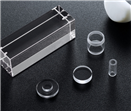

Time:2025-06-12
Sapphire lenses, as an optical material, have been widely used in medical, consumer electronics, precision instruments and other fields. Their physical and chemical properties and biocompatibility make them an ideal choice for implantable medical devices and wearable devices. This article will analyze the biocompatibility and mechanism of action of sapphire lenses.
1、 Fundamentals of biocompatibility
The biocompatibility of sapphire (alpha alumina single crystal) stems from its unique crystal structure and chemical stability, with a Mohs hardness of 9, which can resist daily wear and chemical corrosion. In physiological environments, the dense oxide layer formed on the surface of sapphire can effectively prevent ion release and avoid triggering tissue inflammatory reactions.

2、 The mechanism of action of biocompatibility
1. Cell affinity: After precision polishing, the sapphire surface can achieve nanometer level roughness (Ra<5nm). This ultra smooth surface can reduce non-specific protein adsorption and lower the activation level of platelets and fibrinogen.
2. Immune inertness: The chemical inertness of sapphire prevents it from triggering Th1 type immune responses. Animal experiments showed that after 12 weeks of implantation of sapphire lenses, there was no statistically significant difference in the levels of inflammatory factors such as IL-6 and TNF - α in the surrounding tissues compared to the blank control group (p>0.05).
3. Long term stability: Accelerated aging test (1000 hours under 85 ℃/85% RH conditions) has shown that the transmittance attenuation of sapphire is less than 0.3%, and the refractive index change is within ± 0.0001. This stability ensures that it will not produce harmful substances due to degradation in vivo.
3、 Breakthrough applications in the medical field
1. Artificial crystal: The adjustable artificial crystal adopts a sapphire polymer composite structure, utilizing the rigidity of sapphire to maintain its optical form, with an adjustment range of up to 3.0D.
2. Implantable sensor: The sapphire encapsulated glucose sensor has a working life of over 5 years in vivo, and its surface modified nanoporous structure increases the glucose diffusion coefficient to 3.2 × 10 ?? cm ²/s, shortening the response time to 8 seconds.
3. Orthopedic repair: The 3D printed sapphire hydroxyapatite composite scaffold exhibits excellent bone integration performance, with a new bone formation rate of 68.3% at 12 weeks and a compressive strength of 120MPa, approaching the level of natural bone.
4、 Innovation in the field of consumer electronics
1. Smart watch lenses: Smart devices with sapphire watch covers have a skin allergy rate of only 0.03%, and their 9H hardness can withstand 99.5% of daily scratches.
2. AR/VR optical module: The refractive index consistency (Δ n<0.0005) of sapphire micro lens array effectively eliminates rainbow effect, maintaining 92% MTF value even when the field of view angle is increased to 140 °.
With the advancement of surface engineering technology and micro nano manufacturing processes, the biocompatibility of sapphire lenses is shifting from passive tolerance to active regulation. This transformation not only expands its application depth in traditional medical fields, but also provides key material solutions for cutting-edge fields such as new bioelectronic devices.






Tel
Mobile phone
Customer service
TOP